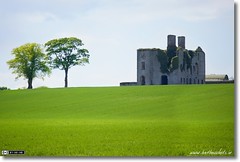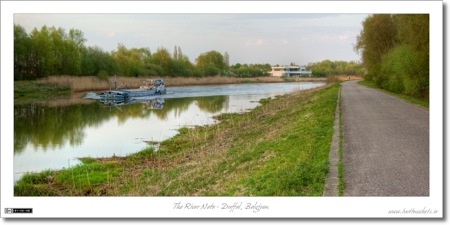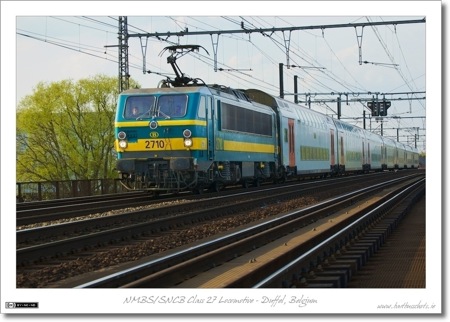May
20
Photo of the Week 65 & 66 – Transportation in Duffel, Belgium
Filed Under Photography on May 20, 2009 | Leave a Comment
Since I’m going to be away next weekend I’m combining this week’s photo of the week with next week’s to give yet another double-installment. As always when I combine two weeks into one, I’ve chosen a theme to unite both shots, in this case, transportation in the Belgian village of Duffel (my birthplace). In some ways these images span centuries. The first is of a heavily laden barge powering down the navigable river that passes through the village, the Nete. The Nete was the best transport link to the village for centuries, if not millennia! The second shows a train on the main line between Brussels and Antwerp which passes through Duffel. This is not the very oldest railway line in continental Europe, but it’s very close, being an extension of the very first one which ran from Brussels to Mechelen. That historic first section of what is now the line form Brussels to Antwerp opened on the 5th of May in 1835, while the remainder of the line, including this section in Duffel, opened a little less than a year later, on the 3rd of May in 1836.
Although Duffel is about 100km from the sea, Belgium is so flat that the Nete is still a tidal river as it passes through Duffel. In fact, at high tide many parts of the village are below the level of the river! For this reason the river is bordered by large dikes on both sides. These dikes are now paved, and serve the local communities as cycle and walking routes. It’s just north of Duffel that the river Nete now connects to the Nete Canal which brings shipping traffic up to the Albert Canal. Because of low bridges and the tidal nature of the river in Duffel, larger boats can only navigate the river at some times of the day, the water being too shallow at low tide, and the bridges too low at high tide. Smaller barges can navigate the river at any time without fear of running aground or crashing into bridges. In this shot we see a barge called Despatch making its way down-stream towards the village of Duffel at the very peak of high tide. As you can see by how low the barge is in the water, she’s clearly fully loaded, probably with coal, sand, or gravel. This kind of barge is low enough to pass under the bridges even at high tide.
- Camera: Nikon D40
- Lens: Nikon DX AFS 18-55mm (D40 kit lens)
- Exposure: 1/320 sec
- Focal Length: 40mm
- Focal Ratio: f/5
- ISO: 400
- Camera Mode: Aperture Priority
- Processing: lightly tonemapped in Photomatic Pro, then the barge was lightened slightly using Aperture’s Dodge & Burn plugin
My second chosen shot is of an evening express service from Antwerp to Brussels crossing the rail bridge over the Nete a little down-stream of Duffel village. This train is making its way along the same track bed that the first train between these two cities ran on way back in 1836. To put that into context, trains have been running here since 60 years after the (US) declaration of Independence. This train is made up of the best coaching stock the NMBS (Belgium’s national railway company, also know as the SNCB) has to offer. These M6 carriages give travellers two decks full of creature comforts on their short and speedy journey between Belgium’s two largest cities. The locomotive pulling the train is an NMBS Class 27 electric locomotive. Although these locomotives are approaching 30 years of age, they are still in fine condition and more than up to the task of whisking passengers between Belgian cities at speeds of up to 160km/h.
- Camera: Nikon D40
- Lens: Nikon DX AFS 18-55mm (D40 kit lens)
- Exposure: 1/500 sec
- Focal Length: 55mm
- Focal Ratio: f/5.6
- ISO: 400
- Camera Mode: Aperture Priority
- Processing: lightened the train a little using Aperture’s Dodge & Burn plugin
May
12
Photo of the Week 63 & 64 – Typical Shutter Bug Photo-Walk
Filed Under Photography on May 12, 2009 | 1 Comment
 Being a week behind again this will be a double-edition of Photo of the Week. This time the ‘theme’ is that both chosen photos were taken on the same day, the 3rd of May 2009. They were taken on the first ever Typical Shutter Bug photo-walk in Ireland. Rather than just post the two chosen photos and a little description of each, I’m going to post a report on the photo-walk first. Then, at the end, I’ll post my two chosen photos with short descriptions. Before I start, I just want to give you all the link to my full photo gallery from the photo-walk on Flickr. It might be fun to follow along there since I’ve geo-tagged all my shots.
Being a week behind again this will be a double-edition of Photo of the Week. This time the ‘theme’ is that both chosen photos were taken on the same day, the 3rd of May 2009. They were taken on the first ever Typical Shutter Bug photo-walk in Ireland. Rather than just post the two chosen photos and a little description of each, I’m going to post a report on the photo-walk first. Then, at the end, I’ll post my two chosen photos with short descriptions. Before I start, I just want to give you all the link to my full photo gallery from the photo-walk on Flickr. It might be fun to follow along there since I’ve geo-tagged all my shots.
May
9
REALLY Short Review of an EeePC
Filed Under 42 (Life the Universe & Everything) on May 9, 2009 | 3 Comments
This is just a quick test post from a friend’s EeePC to see what they’re really like to type on and browse with. My very first impression, I think I have found something worse to type on than a virtual keyboard – a shrunken one! Since it has no smart helper-features like the iPhone, it is actually more tedious than the iPhone. You spend more time correcting mistakes because none of them are auto-corrected. Although you do get better at it as you keep typing, the location of the shift keys in particular really strain your hands. I’ve just typed this much and I can feel the strain already, this is very very far from ergonomic! I’m starting to see Tim Cook’s point, this is not a good experience, and I wouldn’t want Apple to clone this experience. I do want Apple to do something in this space, but it has to be something more human-friendly than this! This feels like miniaturisation for the sake of miniaturisation. I’m not sure what creatures the EeePC was designed for ergonomically, but it was most certainly not adult Homo sapiens! The one good thing I’ll say is that the screen is better than I was expecting, sure the resolution is small by real laptop or desktop standards, it’s positively roomy by iPhone standards. I think this would make it a usable web browser, but the keyboard is a waste of space, you can’t useit for serious typing. Take the screen from an EeePC, rotate it to portrail, make it multi-touch, add OS X iPhone, and make thinner, then you’d be on to a winner IMO! For ultimate p0wnage, add support for a bluetooth keyboad … oh … and sell it for the price of an EeePC 🙂
May
5
Installing mod_jk for Apache 2.2 on Mac OS X 10.5 Leopard
Filed Under Computers & Tech, System Administration on May 5, 2009 | 17 Comments
Note: these instructions also work on OS X 10.6 Snow Leopard, and OS X 10.7 Lion
A few years ago I did a similar tutorial for installing mod_jk on OS X 10.4 Tiger, but yesterday I discovered that those instructions do not work for Leopard. It took my quite a bit of googling and trial an error, but I’ve found a solution that works, which I’m going to share here. This solution is, in my opinion, a best practices solution, and does not involve any changes to your core apache configuration file (httpd.conf). These instructions are for the default install of Apache 2.2 that comes pre-installed on OS X 10.5 Leopard. I can verify that these instructions work for Tomcat 5.0.30, but I would be 99% sure they should also work un-changed for Tomcat 5.5.X and Tomcat 6.0.X.








